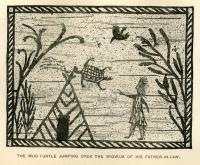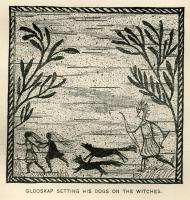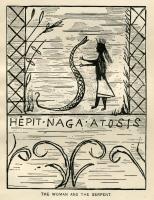Gluskap has survived many hundreds of years and many tellings and retellings.
His story -- in its numerous parts -- has been told by elders to children and others for countless generations.
The stories are entertainment, but much more than that. They are explanations of how things are as well as examples of good behavior or corrections of bad behavior.
The stories live on in image as well as work
Tomah Joseph (1837-1914), a Passamaquoddy Indian living at Peter Dana Point, etched the "Mikamwes" illustration on birchbark for the book Algonquin Legends of New England or Myths and Folk Lore of the Micmac, Passamaquoddy, and Penobscot Tribes by Charles G. Leland (1884).
Joseph also incorporated images relating to Gluskap stories on his baskets and other birchbark work, for which he was very well known.
Gluskap, the heroic figure, was good. He was a giant, although he appeared to the Wabanaki as one of them, in human form.
His twin brother was not good. Some versions of the story of the twins suggest that the brother, often called Malsum, the wolf, was born out of his mother's side, killing her.
Malsum, who also had great power, did not want Gluskap in his way, and attempted to kill him. Gluskap outsmarts his brother and the "bad" brother dies.
Gluskap is powerful and wise -- but neither perfect nor the sole powerful force in Wabanaki belief.
His friend Mikumwesu, a dwarf, also is quite powerful and helps Gluskap.
The Culloo, depicted here, is a huge bird that lived atop Katahdin. Some stories suggest Culloo had the face of a woman. Others suggest Culloo was like a giant eagle.
The stories also teach lessons about morality and about life in general.
Gluskap's grandmother, with whom he lived, was a woodchuck. She teaches Gluskap lessons, which he passes on to his people.
Gluskap makes mistakes and learns from them.
Among other lessons, he learns to moderate his great power. He once hunted all the animals, so that he would never have to hunt again.
His grandmother explained to him that he should be respectful and take only what he needed.
Some Gluskap stories explain how things came to be.
For instance, Gluskap created humans by shooting an arrow into the heart of a basket tree. Out of the split in the tree came men and women.
The tree, which might be birch or ash, then became sacred. Wabanaki people use ash to make baskets. In harvesting it, they respect the tree as a living part of the same world they inhabit.
Other creation stories from Gluskap suggest humans were made from molded clay.

The Mud-Turtle Jumping Over the Wigwam of His Father-In-Law, ca. 1884
Item 28655 infoMaine Historical Society
Many animals attained their current size and shape after Gluskap created humans and asked the animals how they would interact with them. If they sounded threatening, Gluskap shrank them or otherwise altered them so that they could not dominate humans.
Turtle got his shell because he was lazy and liked to play games, like jumping over wigwams. He got stuck on the center pole.
The smoke coming out of the wigwam made turtle hard and formed a shell on his back. It also made patterns on the shell.
In many of the stories, animals and humans often changed form and resembled one another.
The shifts suggest the interrelationships of humans and animals.
It was hard for other cultures to understand Wabanaki beliefs and traditions because of the unique relationship the tribes had with nature.
The stories and legends have persisted in Indian culture as has the storytelling tradition.
The stories of Gluskap as well as other Wabanaki legends offer an important source of information about the native peoples of Maine and the surrounding area.











